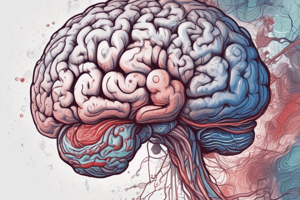Podcast
Questions and Answers
What are the two main types of strokes mentioned in the text?
What are the two main types of strokes mentioned in the text?
- Thrombotic and embolic
- Ischemic and hemorrhagic
- Hemorrhagic and diabetic
- Hemorrhagic and obstructive (correct)
What is the primary risk factor for hemorrhagic strokes according to the text?
What is the primary risk factor for hemorrhagic strokes according to the text?
- Weak blood vessels from birth
- Diabetes
- Severe angles in blood vessels
- High blood pressure (correct)
How does high blood pressure contribute to the risk of a hemorrhagic stroke?
How does high blood pressure contribute to the risk of a hemorrhagic stroke?
- It results in weak blood vessels from birth
- It causes severe angles in the blood vessels
- Increased pressure inside the blood vessels can cause them to tear (correct)
- It leads to damage to smaller blood vessels in the brain
How does diabetes primarily affect blood vessels according to the text?
How does diabetes primarily affect blood vessels according to the text?
What can increase the risk of experiencing an obstructive stroke?
What can increase the risk of experiencing an obstructive stroke?
Why are people who are inactive particularly susceptible to blood clots?
Why are people who are inactive particularly susceptible to blood clots?
What is the term for a blood clot that forms in the legs?
What is the term for a blood clot that forms in the legs?
What is the appropriate treatment for hemorrhagic strokes?
What is the appropriate treatment for hemorrhagic strokes?
What are some symptoms of recognizing a stroke?
What are some symptoms of recognizing a stroke?
What can lead to ischemia?
What can lead to ischemia?
How can blood clots be caused?
How can blood clots be caused?
Why is it important to manage risk factors such as high blood pressure and diabetes?
Why is it important to manage risk factors such as high blood pressure and diabetes?
Flashcards are hidden until you start studying




